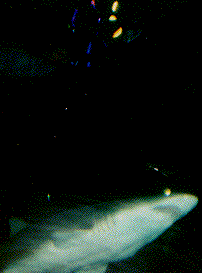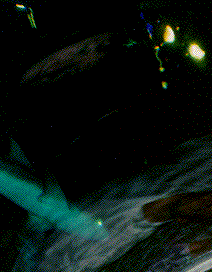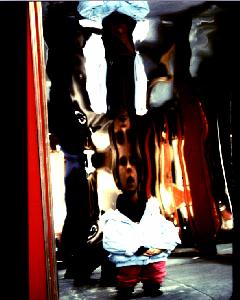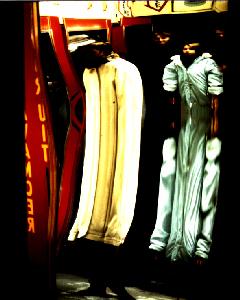|Home|Atmospheric Lensing|Gravitational Lensing|GL Experiment|Examples|References|
5. Other Examples of Caustics and Multiple Imaging
5.1 Gravitational lensing and the wine glass experiment
The formation of multiple images of a distant quasar by the gravitational
lensing effects of a foreground galaxy may be very simply, and faithfully, accounted for by the wine glass experiment described below.
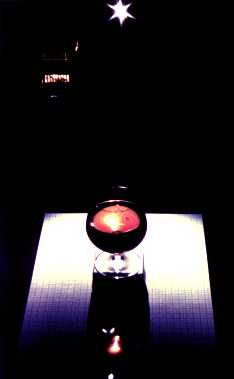 Figure 1:
The wine glass experiment. A bright compact light source
is used as a distant quasar. The wine glass set on the
table (cf Figure 2) distorts the light rays from the quasar and
produces a caustics having a triangular shape (see the enlargment in Figure
3). In order to see the multiple images from the distant "quasar", put the
glass at the very edge of the table and one of your eyes around the caustics
(see text)
Figure 1:
The wine glass experiment. A bright compact light source
is used as a distant quasar. The wine glass set on the
table (cf Figure 2) distorts the light rays from the quasar and
produces a caustics having a triangular shape (see the enlargment in Figure
3). In order to see the multiple images from the distant "quasar", put the
glass at the very edge of the table and one of your eyes around the caustics
(see text)
In order to successfully make this experiment, please use as the quasar light
source a candle, or a bright compact light source as shown in Figure 1. This
light source is set at a typical distance of several meters, and somewhat
higher, from a table on which a glass full of wine is placed. Like a
gravitational lens, the wine glass distorts the background field. This space
distortion is very well seen through the glass in Figure 2. Because of the
presence of the wine glass, the distribution of light on the table is no
longer uniform (see Figure 1). Just behind the glass, higher concentrations
of light may be seen at some locations in the form of a caustics (i.e. the
intersection of a three-dimensional caustics with the plane of the table). The
latter is, in the present case, approximately triangular. The three
sides and summits of this triangular caustics are named folds and
cusps, respectively.
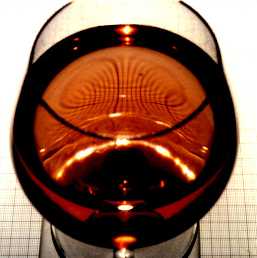 Figure 2: When looking through the wine glass, the distortion of the background field (millimetric paper) by the lens is very conspicuous
Figure 2: When looking through the wine glass, the distortion of the background field (millimetric paper) by the lens is very conspicuous
A blow up of this caustics is shown in Figure 3. The folds result from the envelope of pairs of tangent light rays from the candle. As a result, an
observer setting his eye on a fold will see a pair of merging images from the
distant quasar. Three merging images will be seen at the location of a cusp.
In order to be able to put your eye at various locations with respect to the
caustics, it is recommended to put the glass at the very edge of the table.
You may then also observe that the total number of images increases by two
when your eye crosses a fold from outside to inside the caustics. Figure 4
shows a photograph made with a camera set up at the center of the caustics. Up
to 9 different images of the compact light source are visible. As an exercise,
draw the various diagrams showing the multiple image configurations of the
background light source for different positions of your eye with respect to
the caustics (folds and cusps) and compare them with the multiple image
configurations observed for the known cases of multiply imaged quasars (a
gallery of pictures illustrating various cases of multiply imaged quasars is
available via the URL:
https://vela.astro.uliege.be/grav_lens/.
Note that the formation of caustics of light is a very generic feature in
nature. It arises whenever a foreground object (cf. the wine glass in the
above experiment, a galaxy acting as a gravitational lens, the wavy interface
between air and water in a swimming pool, on a lake, etc.) distorts the
propagation of light rays from a distant light source. For instance, for each
pair -among the billions- of quasars and galaxies that exist in the Universe,
a more or less complex three dimensional caustics is formed behind each
galaxy. Whenever an observer lies close to such a caustics, the former sees
multiple images of the distant quasar. Due to the relative motion between the
quasar, the lensing galaxy and the observer, this phenomenon does not last for
ever. It can be shown that the typical lifetime of a cosmic mirage involving a quasar and a
lensing galaxy is of the order of 20 million years.
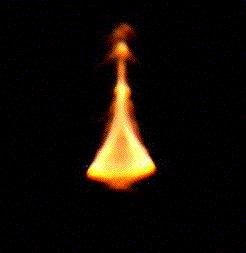 |
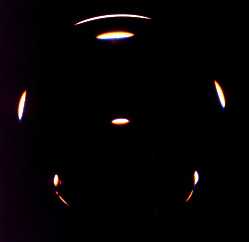 |
| Figure 3:Enlargment of the triangular caustics visible in Figure 1. The caustics results from the redistribution of light rays emitted from the "quasar" by the wine glass |
Figure 4:Multiple images of the compact light source seen by the objective of a photographic camera placed near the center of the caustics |
5.2 Multiple imaging as seen by whales and sharks
As already stated in the previous section, because of the wind, the interface
between the air and the water in a swimming pool, on a lake, on a sea, etc.,
is wavy and as a result, the propagation of light rays from a
distant source (cf. the sun, the moon, etc.) gets distorted after entering
water. Here also, complex caustics are formed and Figure 5a reproduces a view
of such caustics projected on the body of a swimmer in a pool. Figure 5b
illustrates also very well the caustics projected on the body of a whale, as
drawn by the famous american painter Miller. There is consequently no doubt
that, whenever one of the eyes of a whale crosses the folds (resp. the cups)
of the complex caustics, the sun, the moon ... appear to them in the form of,
continuously moving and changing, multiple images. Such multiple images, seen
by real sharks inside the large pool at Sea World (Orlando), have been
photographed and are reproduced in Figures 6a and 6b.
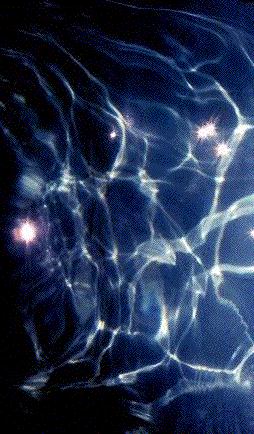 | 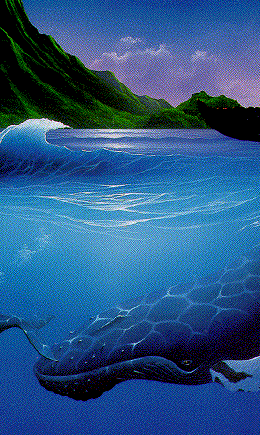 |
Figure 5:
Caustics of light projected on the bottom of the swimming pool (left), and on the body of a whale, as painted by Miller (right).
The sun (left) and moon (right) light acts in these case as the distant
light source.
Figure 6:
Multiple images seen by sharks in the large pool at Sea
World (Orlanda, Florida).
5.3 Multiple imaging at the House of Mirrors
Finally, it is fun to observe multiple images of human beings at the
House of Mirrors, available during most of the big city fairs. Such mirages
are produced by curved mirrors which distort light rays emitted from the
surroundings. Several photographs taken during the Liège october fair in
1989 are reproduced in Figures 6a and 6b.
Figure 7:
Multipe images of an astronomer's daugthers photographed
at the House of Mirrors during the Liège october fair in 1989
References
Surdej, J.: 1990, review paper, Lecture Notes in Physics, Gravitational Lensing, eds Y. Mellier et al., Vol.360, p.57, "Observational aspects of gravitational lensing"
Refsdal, S., Surdej, J.: 1992, First invited discourse, XXIst IAU General Assembly, Highlights in Astronomy, ed. J.Bergeron, Vol.9, p.3, "Gravitational Lensing"
Refsdal, S., Surdej, J.: 1994, Reports Progress in Physics, Vol.57, 117, "Gravitational Lenses"
Surdej, J., Refsdal, S., Pospieszalska-Surdej, A., 1993, 31st Liège International Astrophysical Colloquim, Gravitational Lenses in the Universe, eds J.Surdej et al., p.199, "The optical gravitational lens experiment"
Surdej, J., Refsdal, S., Pospieszalska-Surdej, A., 1995, IAU, Symposium No.173, Astrophysical Applications of Gravitational Lensing, eds C.S. Kochanek and J.N. Hewitt, p.417, "Formation of giant luminous arcs and arclets using an optical gravitational lens experiment"
 Figure 1:
The wine glass experiment. A bright compact light source
is used as a distant quasar. The wine glass set on the
table (cf Figure 2) distorts the light rays from the quasar and
produces a caustics having a triangular shape (see the enlargment in Figure
3). In order to see the multiple images from the distant "quasar", put the
glass at the very edge of the table and one of your eyes around the caustics
(see text)
Figure 1:
The wine glass experiment. A bright compact light source
is used as a distant quasar. The wine glass set on the
table (cf Figure 2) distorts the light rays from the quasar and
produces a caustics having a triangular shape (see the enlargment in Figure
3). In order to see the multiple images from the distant "quasar", put the
glass at the very edge of the table and one of your eyes around the caustics
(see text)
 Figure 2: When looking through the wine glass, the distortion of the background field (millimetric paper) by the lens is very conspicuous
Figure 2: When looking through the wine glass, the distortion of the background field (millimetric paper) by the lens is very conspicuous




